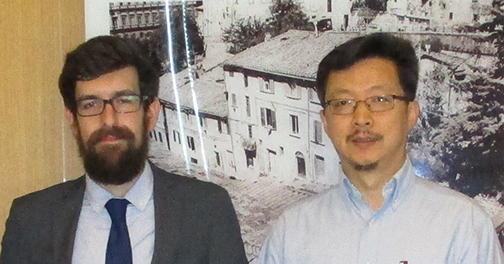Wang lab identifies RNA structure role in membraneless organelle formation

As scientists have delved deeper into the biology of cell dynamics and human diseases, one of the processes that continue to emerge is the formation and disassembly of membraneless organelles—bodies of concentrated RNA and protein. Unlike membrane-bound organelles, these bodies or granules are not surrounded by a membrane but held together by biochemical and physical interactions between the RNA and protein building blocks.
In a new study in Nucleic Acids Research from the lab of Jiou Wang, PhD, associate professor in the Department Biochemistry and Molecular Biology, showed that RNA structures called G-quadruplexes play a role in the formation and function of a type of granule called a paraspeckle. The research was led by Eric Simko, a recent PhD graduate from the lab who is now a postdoctoral fellow at the National Cancer Institute’s RNA Biology Laboratory.
Wang described this work as part of his lab’s interest in both the fundamental biology of RNA and protein homeostasis and their potential implications in human diseases.
“Paraspeckles remain an enigmatic organelle that provides a fascinating model for studying formation of membraneless bodies. Pathologies in paraspeckles have been found in neurodegenerative diseases,” said Wang. Paraspeckles are found in the nucleus and are believed to help control gene expression through diverse pathways. They play a role in a variety of physiological processes, including those in the nervous system and in fertility in females. The paraspeckles themselves are built on a physical scaffolding of a long non-coding RNA, or lncRNA, called NEAT1. Each paraspeckle consists of approximately 50 NEAT1 ribonucleoprotein particles. But scientists didn’t know what elements mediated the interactions between NEAT1 lncRNA and its key protein partners, although some researchers hypothesized that three-dimensional structures could play a role.
“We noticed that a group of related proteins display binding preference for a particular RNA structure and wondered if this mode of binding could contribute to the recruitment of these proteins to the long non-coding RNA NEAT1,” a key step in paraspeckle formation, said Simko.
The RNA structure Simko and colleagues studied was the G-quadruplex, a four-stranded structure formed by guanine-rich RNA. Although G-quadruplexes are known to play a role in numerous basic biological processes, they are especially important in ALS since the repeat expansion in the C9orf72 gene, a common cause for ALS, leads to the accumulation of toxic RNAs that form stable G-quadruplexes. The Wang lab’s previous work on C9orf72 provided a clue that prompted the current investigation.
“We previously found that C9orf72 repeat RNA interacts with a number of proteins in a G-quadruplex-dependent manner,” said Wang, “Eric noticed that there are several paraspeckle proteins among those interacting with C9orf72 repeat RNA, which led us to look closely at how the paraspeckle proteins interact with their scaffold RNA, NEAT1, in a structure-dependent manner.”
To test their hypothesis, the authors began by studying an RNA-binding protein called NONO, which is recruited to the paraspeckles by NEAT1. They found that NEAT1 recruitment of NONO was increased under the conditions favoring the formation of G-quadruplexes. The binding of NONO to the G-quadruplexes was specific to that structure as identical RNAs not in the form of quadruplexes had a much lower affinity for the protein.
The researchers found that the NEAT1 lncRNA contains numerous G-quadruplex motifs, many of which were clustered around the ends of the RNA. Binding experiments showed that NONO recognized the G-quadruplexes in NEAT1 both in vitro and in cells, and that this recognition was crucial to their association. When they examined the equivalent NEAT1 lncRNA in other species, they found that although the nucleic acid sequence didn’t seem to correspond, all of the NEAT1 homologues were enriched in G-quadruplexes.
Simko explained that non-coding RNAs like NEAT1 are often hypervariable, making it difficult to identify functionally important regions. “For this reason, the finding that G-quadruplex motifs are abundant not only on human NEAT1, but on homologues with little similarity to the human NEAT1 sequence was particularly surprising and informative,” he said.
Taken together, these results show the importance of G-quadruplexes in the formation of paraspeckles, and also provide another avenue by which the C9orf72 repeat expansion could interfere with normal cellular functioning.
“Suggesting that the NEAT1 lncRNA utilizes structural motifs to initiate paraspeckle formation, our findings provide a framework for further exploration of the role of RNA secondary structure in the formation, function, and pathological disruption of paraspeckles and other membraneless organelles,” said Simko.
This post is adapted from a Packard Center Research Byte.
